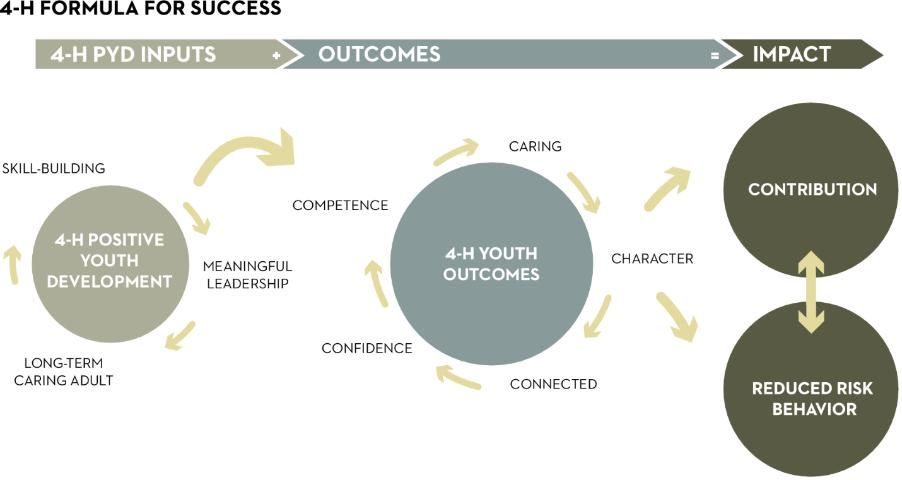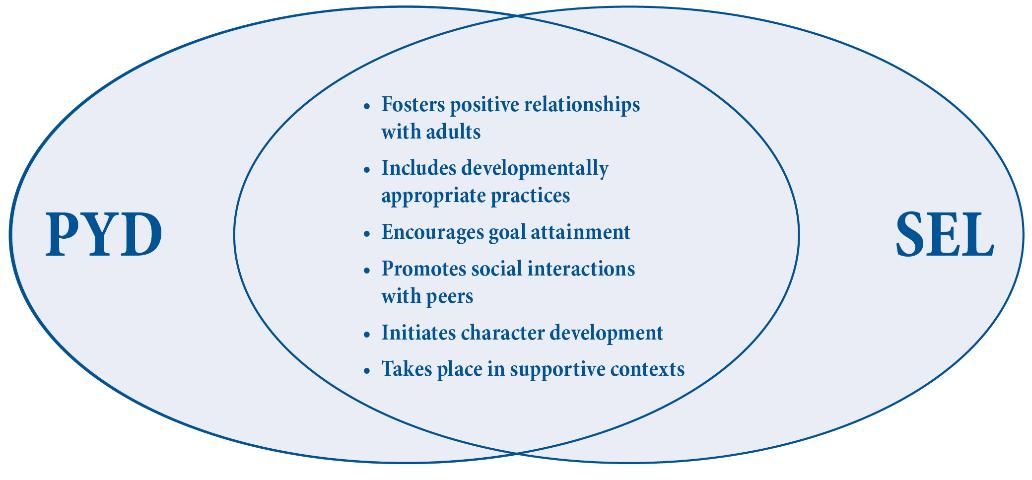What is Positive Youth Development (PYD)?
Positive Youth Development, according to Youth.gov (2019) is "an intentional, prosocial approach that engages youth within their communities, schools, organizations, peer groups, and families in a manner that is productive and constructive; recognizes, utilizes, and enhances young people's strengths; and promotes positive outcomes for young people by providing opportunities, fostering positive relationships, and furnishing the support needed to build on their leadership strengths."
In short, PYD provides the following three features (Blum, 2003; Lerner, 2003; Roth & Brooks-Gunn, 2003):
- Positive, sustained relationships between youth and adults
- Activities that build important life skills
- Opportunities for youth to use these life skills as both participants in and leaders of valued community activities
The following illustration of the 4-H Formula for Success sums up PYD in terms of inputs, outcomes (utilizing the 5Cs of Connection, Caring, Competence, Character, and Confidence), and impacts in a logic-model format.

Credit: Reprinted from "The Positive Development of Youth: Comprehensive Findings from the 4-H Study of Positive Youth Development" (Lerner et al., 2003) with permission of National 4-H Council.
For more information on how 4-H utilizes PYD, refer to Norman & Jordan (2006, 2018 reprint), Introducing 4-H Youth Development (https://edis.ifas.ufl.edu/publication/4h235) and Reviewing 4-H Youth Development Principles (https://edis.ifas.ufl.edu/publication/4h237).
What is Social Emotional Learning (SEL)?
According to the Collaborative for Academic, Social, and Emotional Learning, otherwise known as CASEL (2019), "Social and emotional learning (SEL) is the process through which children and adults understand and manage emotions, set and achieve positive goals, feel and show empathy for others, establish and maintain positive relationships, and make responsible decisions."
Some of the features that SEL promotes, according to "Research Brief of Schools: Social and Emotional Learning: The Foundation of Student Success in School, Work and Life" from the University of Illinois (2008) include:
- Providing a safe, caring, participatory environment
- Emphasizing relationships and emotion as part of SEL
- Addressing the needs of the whole child
SEL builds on five competency areas as defined by CASEL (2019):
- Self-awareness: recognizing strengths and limitations with a well-grounded sense of confidence, optimism, and a "growth mindset."
- Self-management: managing stress effectively, controlling impulses, and motivating oneself to set and achieve goals.
- Social awareness: understanding the perspectives of others, including those from diverse backgrounds and cultures, and empathizing with them.
- Relationship skills: Communicating clearly, listening well, cooperating with others, resisting inappropriate social pressure, negotiating conflict constructively, and seeking and offering help when needed.
- Responsible decision-making: Making constructive choices about personal behavior and social interactions based on ethical standards, safety, and social norms.
Bringing PYD and SEL Together: How They Overlap
Just as 4-H uses PYD as a framework, schools use SEL as a framework. According to Elias et al. (1997), "when schools attend systematically to students' social and emotional skills, the academic achievement of children increases, the incidence of problem behaviors decreases, and the quality of the relationships surrounding each child improves. And, [sic] students become the productive, responsible, contributing members of society that we all want." A whole-program approach with an appropriate curriculum provides the skills necessary for youth to succeed.
The overlaps in PYD and SEL are summarized in the below graphic:

Social Emotional Learning promotes knowledge, responsibility, and caring. PYD promotes building life skills, leadership, and relationships. Both philosophies take a whole child approach to working with youth to not only foster learning but also gain independence and life skills that will benefit youth through their childhood years and into adulthood. Some practitioners feel all SEL is PYD but not all PYD is SEL. Either way, they are both youth-development practices. Understanding how PYD and SEL work together while framing it in a context that works toward intentional youth development allows professionals to envision successful partnerships in school-based settings, which is the goal.
For more resources on SEL, refer to:
- Brand, B. (2016). Turning games into social-emotional skill building. EC005. Washington State University. Retrieved from: https://files.eric.ed.gov/fulltext/EJ1145092.pdf. Accessed 23 May 2019.
- Walker, K., Olson, B., & Herman, M. (2017). Social and emotional learning in practice: A toolkit of practical strategies and resources. St. Paul, MN: University of Minnesota Extension.
- Smith, C., McGovern, G., Larson, R., Hillaker, B., & Peck, S. (2016). Preparing youth to thrive: Promising practices for social emotional learning. Forum for Youth Investment, Washington, D.C.
References
Arnold, M. E., & Gifford, L. (2014). YA4-H! Youth advocates for health – Building successful youth-adult partnerships. Oregon State University Public Health Extension: Corvallis OR.
Child Development Institute. (2018). Erik Erikson's stages of social-emotional development. Retrieved from: https://childdevelopmentinfo.com/child-development/erickson/#.XQEHyqHsZyw. Accessed 12 June 2019.
Collaborative for Academic, Social, and Emotional Learning. (2019). What is SEL? Retrieved from: https://casel.org/what-is-sel/. Accessed 23 May 2019.
Elias, M. J., Zins, J. E., Weissberg, R. P., Frey, K. S., Greenberg, M. T., Haynes, N. M., Kessler, R., Schwab-Stone, M. E., & Shriver, T. P. (1997). Promoting social and emotional learning: Guidelines for educators. Alexandria, VA: ASCD.
Frey, N., Fisher, D., & Smith, D. (2019). All learning is social and emotional: Helping students develop essential skills for the classroom and beyond. Alexandria, VA: ASCD.
Hurd, N., & Deutsch, N. (2017). SEL-focused after-school programs. The Future of Children, 27(1), 95–115. Retrieved from: https://files.eric.ed.gov/fulltext/EJ1145092.pdf. Accessed 23 May 2019.
Jones, S., Brush, K., Bailey, R., Brion-Meisels, G., McIntyre, J., Kahn, J., Nelson, B., & Stickle, L. (2017). Navigating SEL from the inside out: Looking inside and across 25 leading SEL programs: A practical resource for schools and OST providers. Harvard Graduate School of Education, the Wallace Foundation. Retrieved from: https://www.wallacefoundation.org/knowledge-center/Documents/Navigating-Social-and-Emotional-Learning-from-the-Inside-Out.pdf. Accessed 23 May 2019.
Lerner, R. M., Lerner, J. V., & Colleagues. (2003). The positive development of youth: Comprehensive findings from the 4-H study of positive youth development. Institute of Applied Research in Youth Development, Tufts University. Printed by National 4-H Council. Retrieved from: https://4-h.org/wp-content/uploads/2016/02/4-H-Study-of-Positive-Youth-Development-Full-Report.pdf. Accessed 23 May 2019.
Norman, M., & Jordan, J. (2006). Introducing 4-H youth development. 4HFFS101.2. Gainesville: University of Florida Institute of Food and Agricultural Sciences. Retrieved from https://edis.ifas.ufl.edu/publication/4h235. Accessed 23 May 2019.
Norman, M., & Jordan, J. (2006). Reviewing youth development principles. 4HSFS101.4. Gainesville: University of Florida Institute of Food and Agricultural Sciences. Retrieved from https://edis.ifas.ufl.edu/publication/4h237. Accessed 23 May 2019.
University of Illinois Extension. (2008). Research brief of schools: Social and emotional learning: The foundation of student success in school, work and life. Retrieved from: https://extension.illinois.edu/sel/pdf/sel_research_brief_for_schools_2008-04-15.pdf. Accessed 23 May 2019.
Youth.gov. (2019). Positive youth development. Retrieved from https://youth.gov/youth-topics/positive-youth-development. Accessed 23 May 2019.